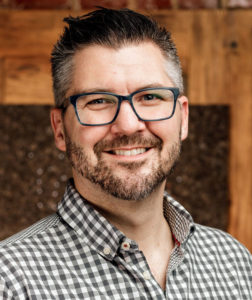Curationist in Conversation: CHRISTIAN DAWSON & HILARY OSBORNE
Meet two of the founding team members who helped make Curationist real:


What brought you to Curationist?
Christian Dawson: The MHz Foundation has been educating people in America about cultures of the world through broadcasting arts and culture programming over the air. Traditional over-the-air broadcasts were becoming less feasible and were also becoming less relevant in an increasingly online world. Given that, they looked to shift into new markets to continue to promote their mission.
Hilary and I were tasked with developing a strategy that allowed them to drive their mission. What brought us to the idea of Curationist was literally the act of brainstorming between the two of us. We decided that it was a natural evolution to move from broadcasting to the Internet. At that point, we were experiencing the free knowledge movement in efforts like Wikipedia and other arts and culture works coming online.
We determined there was a missing piece in terms of resources to tell great stories using the public domain content in the world. And we felt as though we could help develop a really important resource by focusing on that part of the market, and contributing to that open knowledge movement. It would allow people to sit in their homes and learn about the cultures of the world that would change their perspectives.
So, I was proud to be able to convince the board to develop Curationist from the brainstorming sessions that Hilary and I did together because I think we’re at the beginning of a cultural touchstone that will really impact the globe.
Hilary Osborne: I think part of why MHz brought Christian and I on was because we believed in their mission of bringing arts and culture to the public in new and innovative ways through broadcasting, and we were well positioned to take their mission and bring it online.
Our idea was to make an arts and culture aggregator that anybody could access. It would be very beautiful, easy to use, and compelling to people who are passionate about a topic and want to learn more about it. We also envisioned it as something that educators and museums could use to supplement the work they already do.
CD: I think we’re off to a pretty good start.
Why is curation such a powerful concept?
CD: Art in-and-of-itself can convey a feeling, but curation is a little bit different because it takes the art and contextualizes it and then builds a story arc that takes you on a journey that teaches you about the perspectives through which the art was generated. So, if you really want to be moved to action and have your mindset shifted, a curated exhibit is essentially a full experience that gives you the context necessary to hit you in the heart and the mind.
HO: The way things are going online — it’s a lot of algorithms that are propelling discovery. It tends to be AI driven; whereas, we want to have that human touch. We wanted people to determine what mattered to them; they were going to pick and choose what matters at any given time. And we have different perspectives from different cultures and different walks of life — it’s not just through one kind of mindset — typically the art world is very money oriented, and this is not that. It’s something that is free to use and accessible to everybody to participate in.
What challenges does the sheer volume of online content pose?
CD: The fact is that search engines are pretty effective in answering any questions you have in the world, but life is more than just trying to answer the questions you have. To change the way you think, you need cultural experiences that a Google search could never provide.
To really rock you to your core, we need some thing that challenges your ideals and goes beyond anything that you even know what to ask about.
That’s why when you go to a museum, you learn things that challenge your perception of how the world works. Our desire is to go beyond what any search can provide didactic answers to. Our desire is to try and introduce you to new concepts you didn’t even know existed and wouldn’t know how to search for in a linear way.
What is something you’ve wanted to know about that you couldn’t “just Google”?
HO: As someone with a design background, I find it interesting, for instance, to know what chairs looked like in the 1940’s — but not just in the UK or North America, but across the world.
When developing Curationist, we thought a lot about how a search tool could bring up results across categories and eras. What we’ve created is an excellent research resource that returns results you wouldn’t be able to get in a museum.
CD: I can’t think of something in particular I couldn’t Google, but I will say that I don’t know many resources online that introduced me to subjects where I don’t already have a kernel of the idea that they existed in the first place. What I’m looking for is something that can introduce me to subjects I never even fathomed were important to me.
When we first sat down and plotted out how Curationist could work, someone started telling me about the cultural importance of Malawi hairstyles, which is something that I had no idea I would have any interest in, much less ever look for. But once I learned about Malawi hairstyles – what it is and its cultural importance — I was fascinated and it was something that resonated in different aspects of my life. So, no, what I really wanted wasn’t something I was interested in and needed curated — I wanted to find things that I never would have thought of put in front of me.
The Internet is a global phenomenon, and yet much of the content is from a Global North perspective. Why do you think it’s important to include different perspectives?
HO: The biggest problem is that even though museums and art galleries are always great to visit, it’s very much curated by the Global North. Not everybody has the luxury of visiting these lovely places around the world or even pay to get in.
CD: I’m a huge fan of music and how it provides a window into the culture that produced it. Musicologists such as John and Alan Lomax did really interesting work when they went into areas where music hadn’t yet been recorded. Of course, they were outsiders trying to bring that music to cultures outside of those environments. At the time, one could argue there was an importance to that. But in today’s global village, we have the opportunity to go beyond the story-teller outside of a circle giving their perspective on the importance of that. We can actually go right to the source, and get the perspectives from the cultures and express them in their own way. I’m excited to be helping drive a vehicle that prioritizes messages from the cultures that produced them, rather than framed by outsiders. It’s not about borrowing from cultures or cultural tourism, but more about wanting to empower people within their regions to tell their stories in the way they want.
The Internet has given us more access to cultural works than ever before. What’s the value of providing context and commentary alongside this content?
HO: I used to use tons of different websites for research. I feel that unless you’re very well-versed in how to search for things on the Internet, you might not know where to look. You might get things here and there, but getting the aspects you’re searching for all together and making connections between them can be difficult, if you don’t know where and how to look. What we’re trying to do with Curationist is shift through all the noise of the Internet and look for things that are based in arts and culture and bring that to you in one website.
Curationist is one website with multiple views.